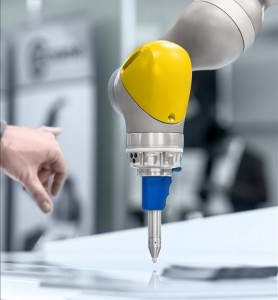Safety considerations with collaborative robots
 Stewart Robinson of TUV SUD Product Service looks at standards relevant to collaborative robots.
Stewart Robinson of TUV SUD Product Service looks at standards relevant to collaborative robots.
Collaborative Robots – sometimes referred to as ‘CoBots’ – are robots that are designed to work alongside humans in a collaborative work-space, an area where the robot and the human can perform tasks simultaneously.
There are many sectors where collaborative operation has some advantages including: medical (where robots are used during various procedures including surgery); healthcare (where robots perform tasks such as assistance with mobility); service (both domestic and professional applications); space (for example on the International Space Station); defence (robots assisting in bomb disposal and “wearable” robots for enhanced mobility); and of course in manufacturing as well as other applications.
The current standards for the use of robots in the manufacturing sector are ‘EN ISO 10218-1:2011 Robots and robotic devices – Safety requirements for industrial robots’ and ‘EN ISO 10218-2:2011 – Part 2: Robot systems and integration’. Both of these standards already contain some guidance on the use of collaborative robots but it is acknowledged that the guidance needs to be enhanced, especially with the rapidly growing technological measures that are being developed and introduced.
With this in mind a Technical Specification is under preparation (ISO/DTS 15066 Robots and robotic devices – Safety requirements for industrial robots — Collaborative operation). There are also working groups of the standards organisations looking at various aspects of ‘human-machine interactions’ which will also inform the development of future standards.
But for now at least the most relevant published guidance is contained in the EN ISO 10218 standards, an HSE Research Report (RR906) “Collision and injury criteria when working with collaborative robots” also has some useful guidance.
Safety measures
In order to ensure that humans are not exposed to unacceptable risks when working collaboratively the standards currently describe four separate measures that can be used to provide risk reduction. It is required that at least one of these requirements needs to be fulfilled in addition to having visual indication the robot is in collaborative operation.
Safety-rated monitored stop: This measure requires that when it is detected that a human has entered the collaborative workspace the robot should be stopped, and the stop condition should be maintained until the human leaves the workspace. The safety related control system that provides this functionality needs to meet PLd with Category 3 architecture (EN ISO 13849), or SIL 2 with hardware fault tolerance (HFT) 1 according to EN [IEC] 62061.
Hand guiding: In this mode the human can guide the robot at the end effector by hand. Additional requirements for safety include safe limited speed monitoring and the use of an ‘enabling device’ (a three position device that has to be held in the centre position) as well as a local emergency stop.
Speed and separation monitoring: In this mode the robot must maintain a specified separation distance from the human and operate at a determined speed. This measure requires careful risk assessment and needs to take account of safety distances with consideration of approach speeds of parts of the human body as described in EN ISO 13855.
Power and force limiting by inherent design or control: In this mode the power and force of the robot actuators need to be monitored by safety related control systems to ensure that they are within limits established by a risk assessment. In all four of the measures described the safety related control systems need to meet PLd with Category 3 architecture (EN ISO 13849), or SIL 2 with hardware fault tolerance (HFT) 1 according to EN [IEC] 62061.
Visit the TUV SUD Product Service website for more information
See all stories for TUV SUD Product Service















